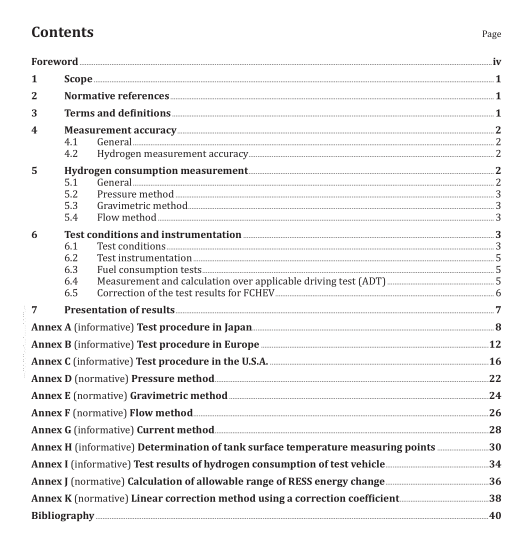ISO 23828:2013 pdf download.Fuel cell road vehicles — Energy consumption measurement — Vehicles fuelled with compressed hydrogen
5.2 Pressure method
Hydrogen consumption is determined by measuring the pressure and temperature of gas in the hydrogen tank before and after the test. A tank with known internal volume that allows measurement of gas pressure and temperature shall be used for the test. Pressure method shall be performed in accordance with Annex D.
5.3 Gravimetric method
Hydrogen consumption is calculated by measuring the mass of the hydrogen tank before and after the test. Gravimetric method shall be performed in accordance with Annex E.
5.4 Flow method
The amount of hydrogen supplied to a vehicle is measured by a flowmeter. Flow method shall be performed in accordance with Annex F.
6 Test conditions and instrumentation
6.1 Test conditions
6.1.1 General
For test conditions, the following applies unless otherwise specified in the regional standards or regulations (see Annex A, B, or C, for example).
6.1.2 Ambient temperature
Tests shall be conducted at an ambient temperature of (25 ± 5) °C.
6.1.3 Vehicle conditions
6.1.3.1 Vehicle conditioning
Prior to testing, the test vehicle shall be stabilized; this includes vehicle mileage accumulation in accordance with a manufacturer-determined distance, unless otherwise specified in Annex A, B, or C.
6.1.3.2 Vehicle appendages
Vehicles shall be tested with normal appendages (mirrors, bumpers, etc.). When the vehicle is on the dynamometer, certain items (e.g. hub caps) should be removed for reasons of safety, where necessary.
6.1.3.3 Vehicle test mass
The vehicle test mass shall be selected according to the regional standards and/or regulations (see Annex A, B, or C, for example).
6.1.3.4 Tyres
6.1.3.4.1 General
The correctly rated tyres as recommended by the vehicle manufacturer shall be used.
6.1.3.4.2 Tyre pressure
The vehicle tyres shall be inflated to the pressure specified by the vehicle manufacturer according to the test chosen (track or chassis dynamometer).
6.1.3.4.3 Tyre conditioning The tyres shall be conditioned as recommended by the vehicle manufacturer. 6.1.3.5 Lubricants The vehicle lubricants normally specified by the manufacturer shall be used.
6.1.3.6 Gear shifting If the vehicle is fitted with a manually shifted gear box, gear shifting positions shall correspond to the regional test procedure (see Annex A, B, or C, for example). However, the shift positions should be selected and determined in accordance with the vehicle manufacturer’s specification.
6.1.3.7 Regenerative braking If the vehicle has regenerative braking, the regenerative braking system shall be enabled for all dynamometer testing except where specified in 6.1.4.4 chassis dynamometer conditions. If the vehicle is tested on a single axle dynamometer and is equipped with systems such as an antilock braking system (ABS) or a traction control system (TCS), those systems can inadvertently interpret the non-movement of the set of wheels that are off the dynamometer as a malfunctioning system. If so, these systems shall be temporally disabled for adjustment to achieve normal operation of the remaining vehicle systems, including the regenerative braking system.
6.1.3.8 RESS conditioning The RESS shall be conditioned with the vehicle as specified in 6.1.3.1 or by equivalent conditioning.
6.1.3.9 Test fuel ISO 14687-2 and the equivalent regional standards shall apply to test fuel.
6.1.4 Chassis dynamometer conditions
6.1.4.1 General The vehicle should generally be tested on a single-axle chassis dynamometer. A vehicle with four-wheel drive shall be tested by modifying the drive train of the vehicle. When the vehicle is modified, the details shall be explained in the test report. Double-axle chassis dynamometer testing should be performed if a modification for single-axle chassis dynamometer testing is not possible for a specific four-wheel drive vehicle.
6.1.4.2 Dynamometer calibration The dynamometer shall be calibrated in accordance with the specifications indicated in the service manual provided by the dynamometer manufacturers. 6.1.4.3 Dynamometer warm-up The dynamometer shall be warmed up sufficiently prior to testing.ISO 23828 pdf download.ISO 23828-2013 pdf download
